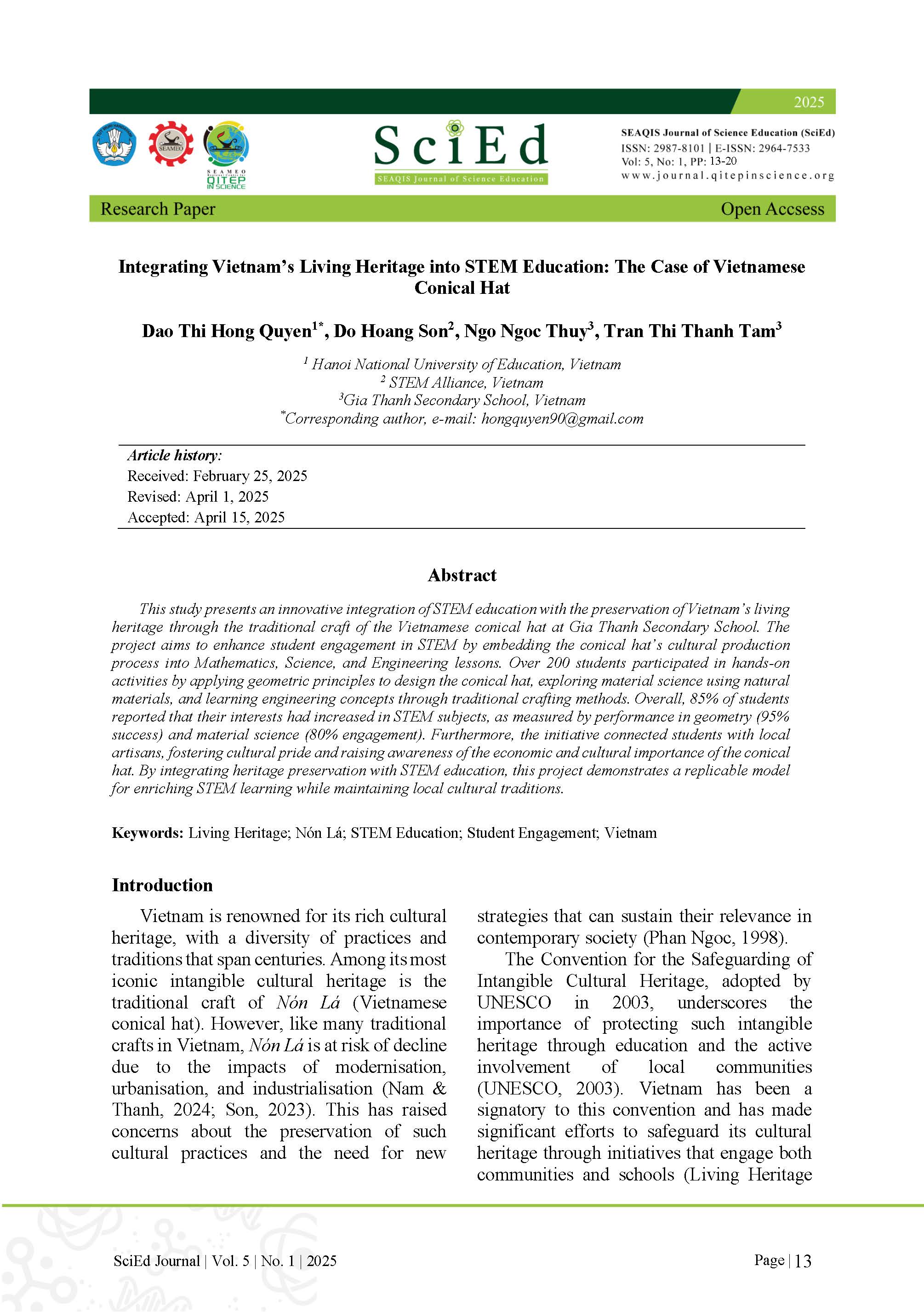Integrating Vietnam’s Living Heritage into STEM Education: The Case of Vietnamese Conical Hat
DOI:
https://doi.org/10.58249/sjse.v5i01.181Keywords:
living heritage, nón lá, STEM education, Vietnam, student engagementAbstract
This study presents an innovative integration of STEM education with the preservation of Vietnam’s living heritage through the traditional craft of the Vietnamese conical hat at Gia Thanh Secondary School. The project aims to enhance student engagement in STEM by embedding the conical hat’s cultural production process into Mathematics, Science, and Engineering lessons. Over 200 students participated in hands-on activities by applying geometric principles to design the conical hat, exploring material science using natural materials, and learning engineering concepts through traditional crafting methods. Overall, 85% of students reported that their interests had increased in STEM subjects, as measured by performance in geometry (95% success) and material science (80% engagement). Furthermore, the initiative connected students with local artisans, fostering cultural pride and raising awareness of the economic and cultural importance of the conical hat. By integrating heritage preservation with STEM education, this project demonstrates a replicable model for enriching STEM learning while maintaining local cultural traditions.
References
Bertoni, M., & Peverada, E. (2023). Engineering design for the cultural world heritage: reflections from the implementation of a challenge-based learning approach. Swedish Engineering Education Development Conference. https://sdgs.un.org/goals
Binbin, T., Sereerat, B., Songsiengchai, S., & Thongkumsuk, P. (2024). The Development of Intangible Cultural Heritage Curriculum Based on Experiential Learning Theory to Improve Undergraduate Students Understanding in Intangible Cultural Heritage. World Journal of Education, 14(1), 43. https://doi.org/10.5430/wje.v14n1p43
Living Heritage Entity. (2022). Basic Texts of the 2003 Convention for the Safeguarding of the Intangible Cultural Heritage 2022 Edition.
Nam, N. T., & Thanh, N. N. (2024). The role of local communities in the conservation of cultural heritage sites: A case study of Vietnam. Journal of Asian Scientific Research, 14(2), 179–196. https://doi.org/10.55493/5003.V14I2.5057
Nguyen, T. P. L., Nguyen, T. H., & Tran, T. K. (2020). STEM education in secondary schools: Teachers’ perspective towards sustainable development. Sustainability (Switzerland), 12(21), 1–16. https://doi.org/10.3390/su12218865
Phan Ngoc. (1998). Vietnam Cultural Identity. Literature Publishing House.
Sang, Y., & Yang, J. (2023). Highlights in Art and Design Research on Cultural tourism Resources of Developing “Intangible Cultural Heritage”-Taking Huaihe Culture as an example. 2(2), 66.
Son, N. H. (2023). Challenges in conserving Intangible Cultural Heritage in Vietnam as seen from the Van Phuc Silk Village. IKAT: The Indonesian Journal of Southeast Asian Studies, 6(2), 118. https://doi.org/10.22146/ikat.v6i2.73993
UNESCO. (2003). The Convention for the Safeguarding of the Intangible Cultural Heritage.
Vuong, Q.-H., Pham, T.-H., Tran, T., Vuong, T.-T., Nguyen, M.-C., Nguyen, K.-L. P., La, V.-P., & Ho, M.-T. (2020). STEM education and outcomes in Vietnam: Views from the social gap and gender issues.
Wang Yuecheng. (2023). How to Integrate Traditional Culture into STEM Teaching. Frontiers in Educational Research, 6(7). https://doi.org/10.25236/fer.2023.060705

Downloads
Published
Issue
Section
Citation Check
License
Copyright (c) 2025 SEAQIS Journal of Science Education

This work is licensed under a Creative Commons Attribution 4.0 International License.

This work is licensed under a Creative Commons Attribution 4.0 International License.










